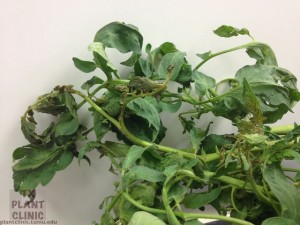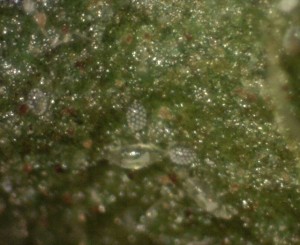One the assignments that are given to undergraduate BESC 484 students who interned at the Texas Plant Disease Diagnostic Lab is to write blog post articles of things that might interest them. This fall, Blake Commer will be providing several of this write-up to fulfill partial requirement for this writing intensive course. Recently, the Plant Clinic received a tomato submission with broad mite damage. The following is a write up about the broad mite on tomato. Enjoy. -KO
Broad Mites Causing Leaf Curling and Stunting in Tomato Plants
 Tomato plants that stand out due to generalized wilting and foliar curling could be suffering from a broad mite infestation. Other common hosts include potatoes, peppers, and cannabis. This less common issue is prominent among greenhouses where plants are closely spaced since broad mites, Polyphagotarsonemus latus, can be transmitted by wind or on flying insects. As they consume the youngest plant material, they excrete a toxin that causes the leaf to curl or shrivel, resulting in a dark and wilted appearance at the top of the plant.
Tomato plants that stand out due to generalized wilting and foliar curling could be suffering from a broad mite infestation. Other common hosts include potatoes, peppers, and cannabis. This less common issue is prominent among greenhouses where plants are closely spaced since broad mites, Polyphagotarsonemus latus, can be transmitted by wind or on flying insects. As they consume the youngest plant material, they excrete a toxin that causes the leaf to curl or shrivel, resulting in a dark and wilted appearance at the top of the plant.
Damage can be very extensive from a small pest population, so symptoms may not be recognized until the infestation is severe, but may also include necrotic veins and bronzing on the undersides of leaves. These symptoms are commonly confused with those of various viruses, herbicide damage, and micronutrient deficiencies, so confirmation is essential for proper treatment. Broad mites can be identified under a dissecting microscope or highly magnified hand lens, and exhibit a wide range of life stages, including eggs, immature larvae, and adult mites. The key to identifying this specific mite is its’ characteristically unique eggs, which appear to be nearly transparent with evenly spaced white specks or dots across the top, sometimes referred to as a “jewel box”. The adults are yellow to brown, range from 0.1-0.3 mm, and are equipped with four sets of appendages. The hind two are typically used to transport the milky colored immature mites, which have not developed the last set of appendages yet.
So, what can you do if you suspect a broad mite issue in your greenhouse or garden? First, microscopic confirmation is critical to ensure that the correct treatment is applied. Next, choose your treatment and decide on a regular routine to prevent recurrence. Success is highest with a variety of acaricides and sulfur-based miticides, however, plants need to be reexamined a few weeks after application as symptoms may briefly continue to develop after the mite infestation has been addressed. The species should also be evaluated prior to treatment to ensure there will not be an adverse reaction or sensitivity that will result in further damage.
For more information about broad mites, check out these webpages:
http://www.ent.uga.edu/veg/solanaceous/broadmite.htm



